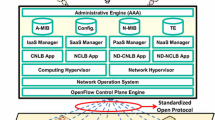Abstract
Virtual Private Network (VPN) services over the Internet are gaining increased acceptance due to the economic benefits and flexibility. However, with difficulties of providing sufficient transmission capacity for value-added and mission-critical services, the Optical VPN (OVPN) deploying Dense Wavelength-Division Multiplexing (DWDM) technology has been seen as a favorable approach for realizing the future VPN services. In an OVPN, the Routing and Wavelength Assignment problem plays a key role for capacity utilization and therefore the Multicast Routing and Wavelength Assignment problem has been the dominant issue in a DWDM-based OVPN. In this paper, using Virtual Source (VS) nodes that have splitting and wavelength conversion capabilities, we propose a new Multicast Routing and Wavelength Assignment method for multicast sessions. The algorithm combines the VS-based tree generation approach with Multi-Wavelength Minimum Interference Path Routing (MW-MIPR) that chooses a path that does not interfere too much with potential future multicast session requests.
Similar content being viewed by others
References
Tomonori Takeda: Framework for Layer 1 Virtual Private Networks, draft-takeda-l1vpn-framework-02.txt. IETF Internet Draft (Oct.2004)
French S. (2004) Dimitrios pendarakis: optical virtual private networks: applications, functionality and implementation. Photonic Network Commun. 7(3): 227–238
Yoon M.-R., Shin J.-D., Jeong C.-H., Jo J.-M., et al. (2004) Optical-LSP establishment and a QoS maintenance scheme based on differentiated optical QoS classes in OVPNs. Photonic Network Commun. 7(2): 161–178
Zhang, X., Wei, J., Qiao, C.: On Fundamental Issues in IP over WDM Multicast. Proceedings of IEEE ICCCN ’99, pp. 84–90. Boston, MA, (Oct. 1999)
Strand J., Chiu A., Tkach L.R. (2001) Issues for routing in the optical layer. IEEE Commun. Magazine. 39(2): 81–87
George N. (2003) Rouskas optical layer multicast: rationale, building blocks, and challenges. IEEE Network, 17(1): 60–65
Hu, X.D., Shuai, T.P., Xiaohua Jia, M.H.: Zhang: Multicast Routing and Wavelength Assignment in WDM Networks with Limited Drop-offs. Proceedings of IEEE INFOCOM 2004, vol. 1, pp. 487–494. PRC, Hong Kong (March 2004)
Sahasrabuddhe L.H., Mukherjee B. (1999) Light trees: optical multicasting for improved performance in wavelength routed networks. IEEE Commun. Magazine. 37(2): 67–73
Malli, R., Zhang, X.C.: Qiao Benefit of Multicasting in All-Optical Networks. SPIE Proc. Conf. All-Optical Networking, vol. 3531, pp. 209–220. Boston, MA (Nov. 1998)
Zhang X., Wei J.Y. (2000) Chunming Qiao Constrained multicast routing in WDM networks with sparse light splitting. IEEE/OSA J. Lightwave Technol. 18(12): 1917–1927
Sreenath, N., Satheesh, K., Mohan, G., Murthy C.S.R.: Virtual source based multicast routing in WDM optical networks. Proceedings of IEEE ICON 2000, pp. 385–389. Singapore, Singapore (Sep. 2000)
Sreenath, N., Krishna Mohan Reddy, N., Mohan, G., Murthy C.S.R.: Virtual source based multicast routing in WDM networks with sparse light splitting. Proceedings of 2001 IEEE Workshop on High Performance Switching and Routing, pp. 141–145. Dallas, Texas (May 2001)
Kar K., Kodialam M., Lakshman T.V. (2000) Minimum interference routing of bandwidth guaranteed tunnels with MPLS traffic engineering applications. IEEE J. Selected Areas Commun. 18(12): 2566–2579
Hwang J.G., Jung J.-I., Park Y.-J., Bae J.-H., et al. (2004) A RWA algorithm for differentiated services with QoS guarantees in the next generation internet based on DWDM networks. Photonic Network Commun. 8(3): 319–334
Bauer D. (2002) Minimum-interference routing based on flow maximization. IEE Electronics Lett. 38(8): 364–365
Kodialam, M., Lakshman T.V.: Minimum Interference Routing with Applications to MPLS Traffic Engineering. Proceedings of IEEE INFOCOM 2000. 2, (884–893 Tel-Aviv, Israel, March 2000)
Figueiredo, G.B., da Fonseca, N.L.S., Monteiro J.A.S.: A minimum interference routing algorithm. Proceedings of 2004 IEEE International Conference on Communications, vol. 4, pp. 1942–1947. Paris, France (June 2004)
Sreenath N., Siva Ram Murthy C., Mohan G. (2001) Virtual Source Based Multicast Routing in WDM Optical Networks. Photonic Network Commun. 3(3): 213–226
Zang H., Jue J.P., Mukherjeee B. (2000) A review of routing and wavelength assignment approaches for wavelength-routed optical WDM networks. Optical Networks Magazine. 1(1): 47–60
Siva Ram Murthy, C., Gurusamy, M.: WDM optical networks: concepts, design, and algorithms. Prentice Hall (2002)
Author information
Authors and Affiliations
Corresponding author
Rights and permissions
About this article
Cite this article
Jo, JM., Lee, SJ., Hong, KD. et al. Virtual source-based minimum interference path multicast routing in optical virtual private networks. Photon Netw Commun 13, 19–30 (2007). https://doi.org/10.1007/PL00022060
Published:
Issue Date:
DOI: https://doi.org/10.1007/PL00022060




